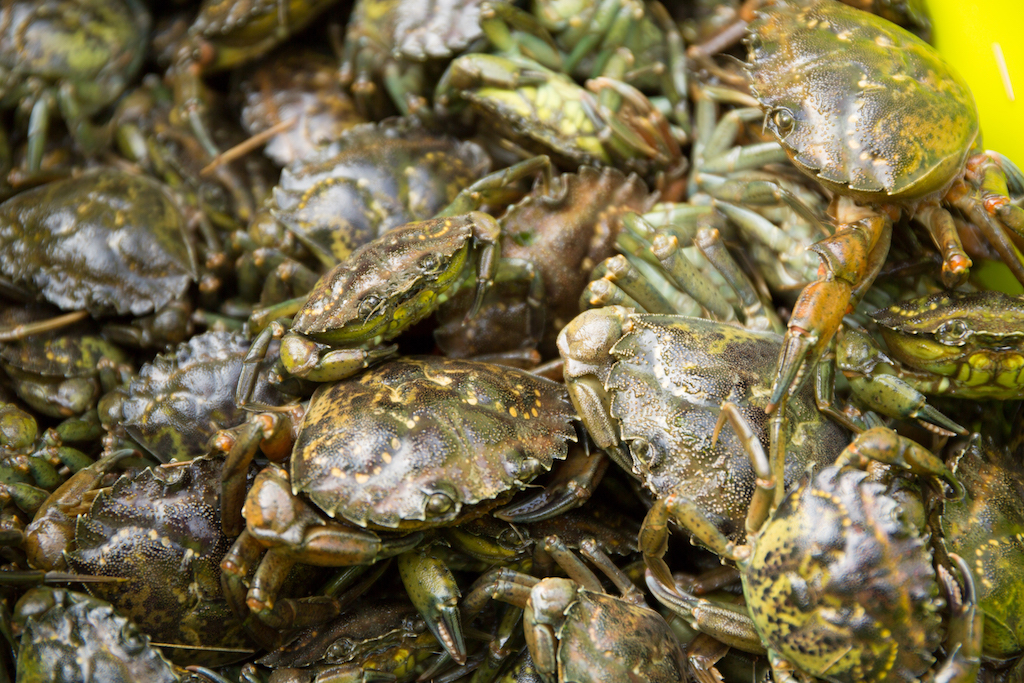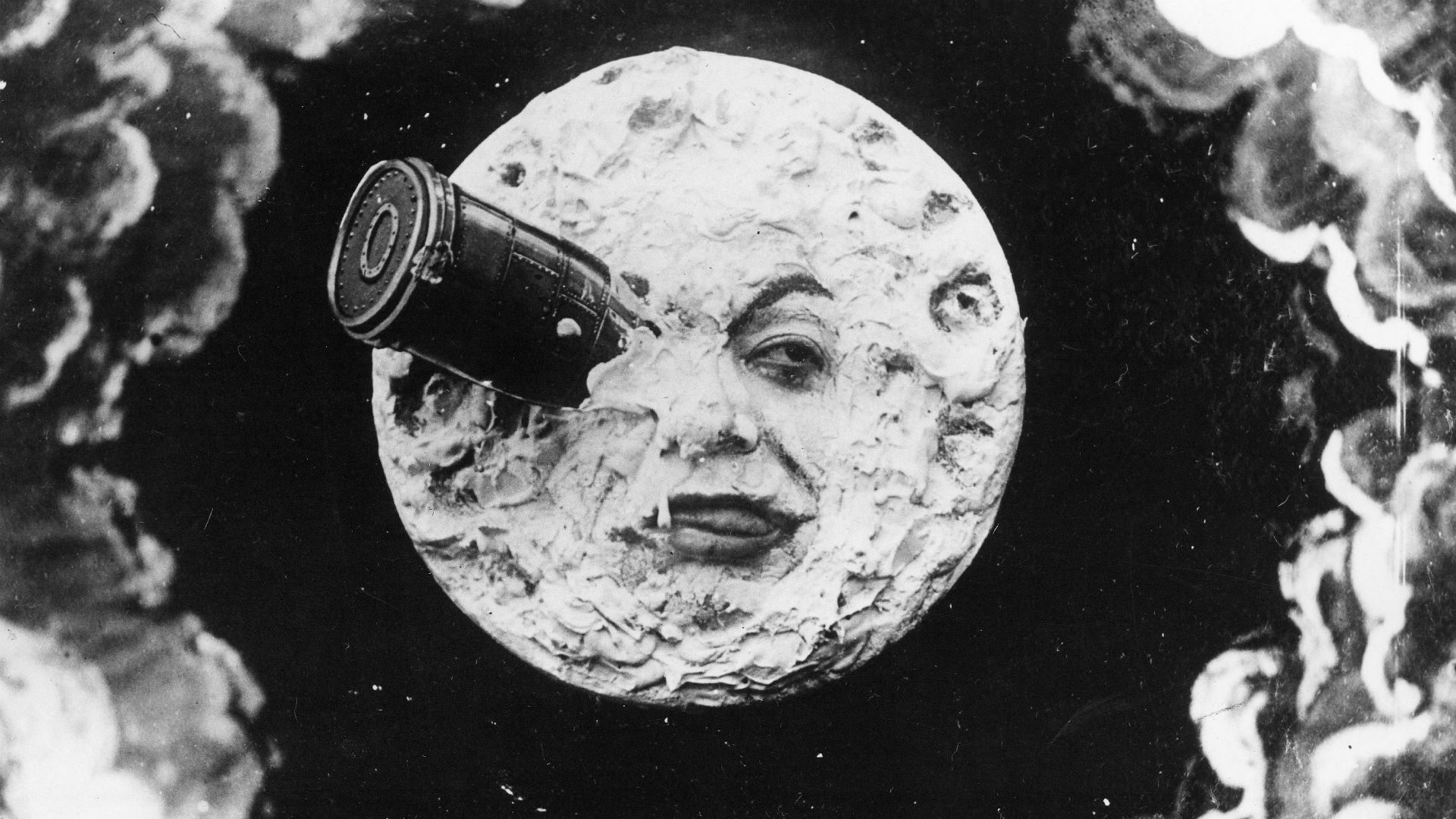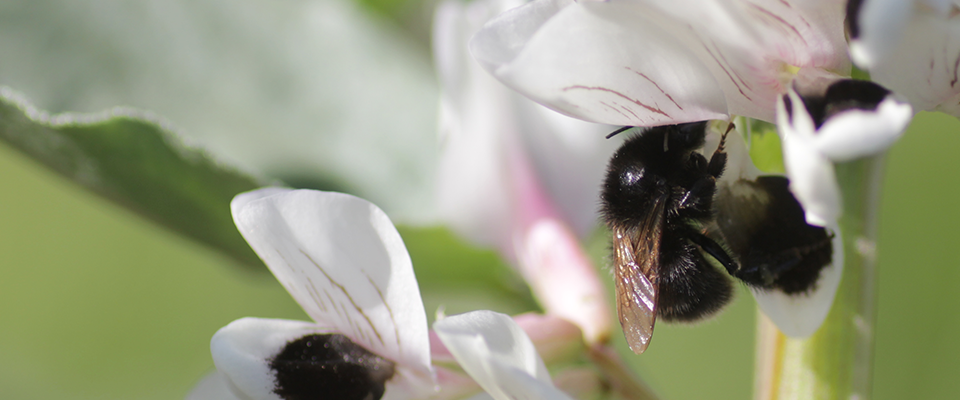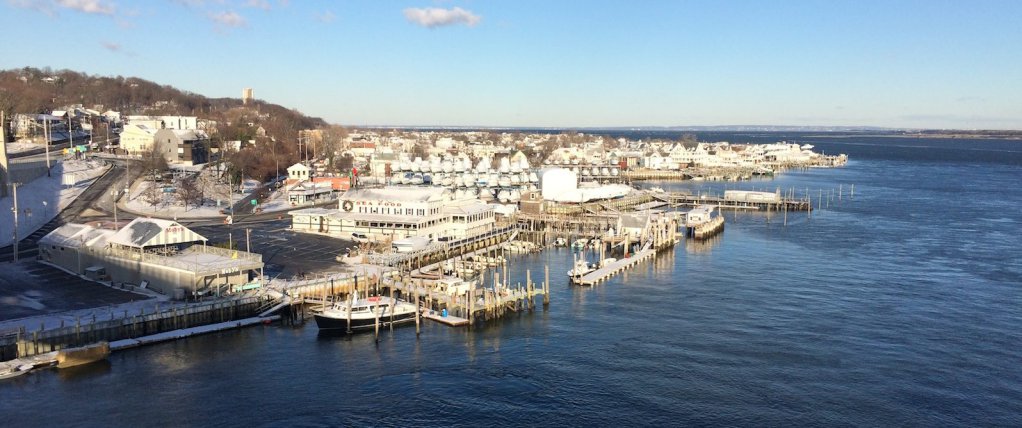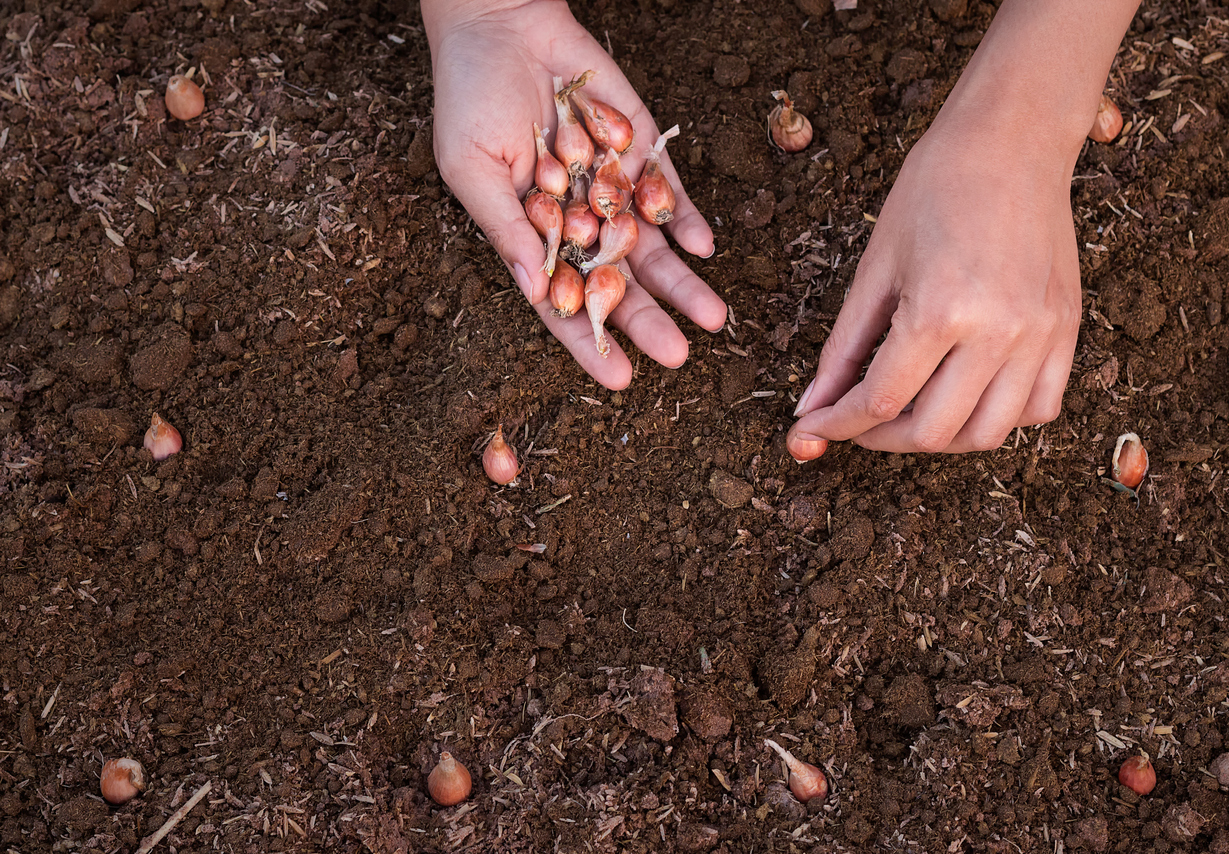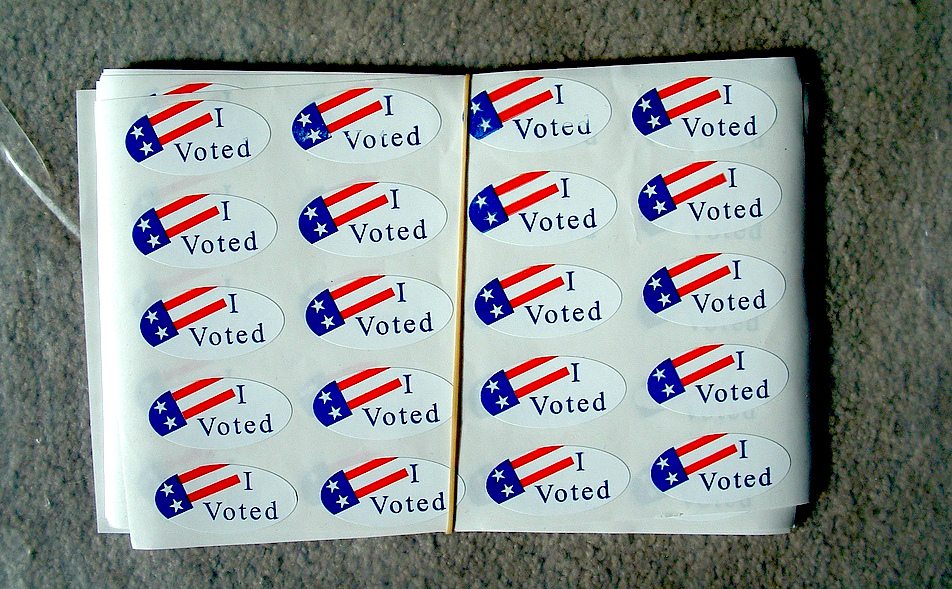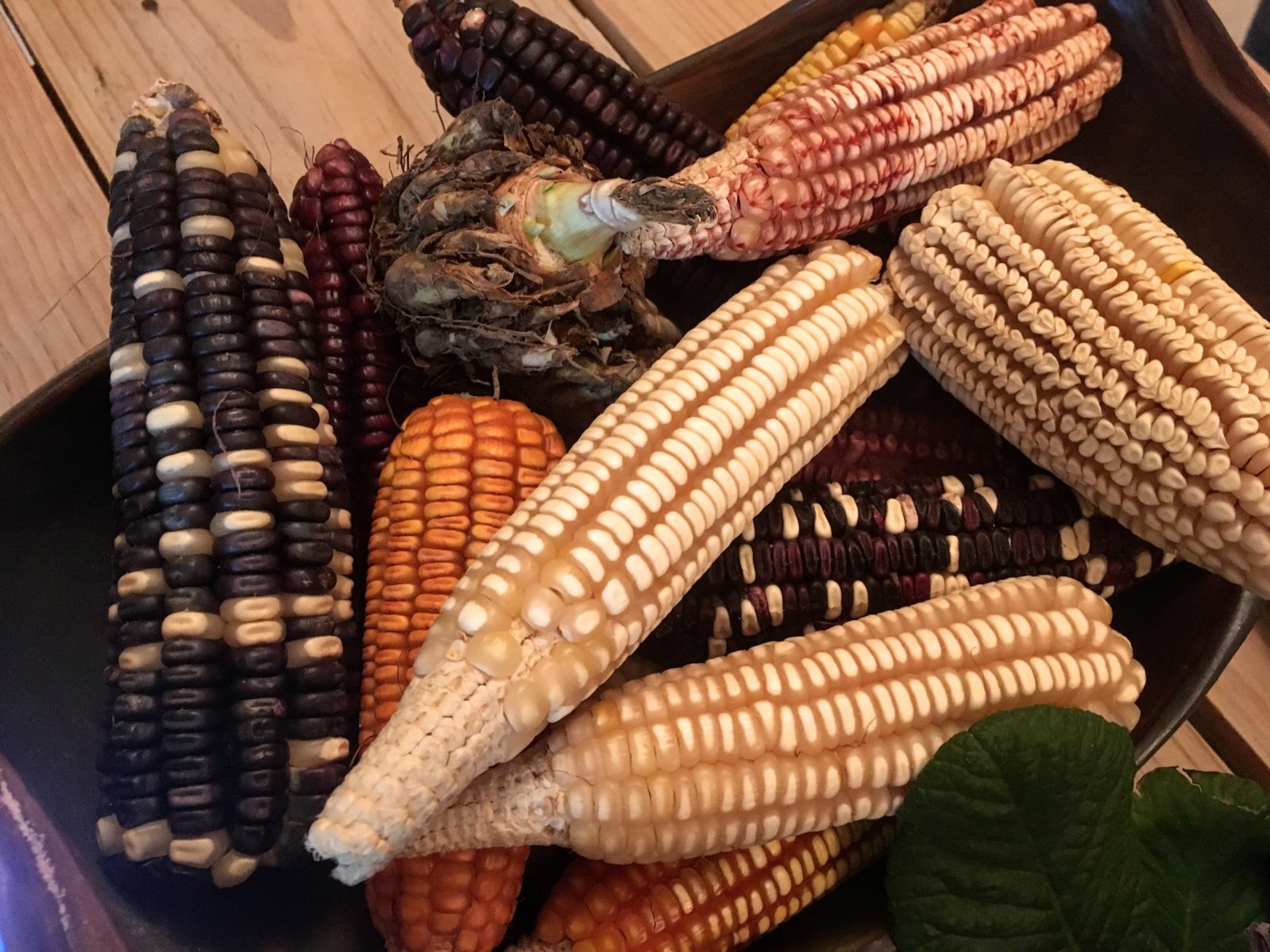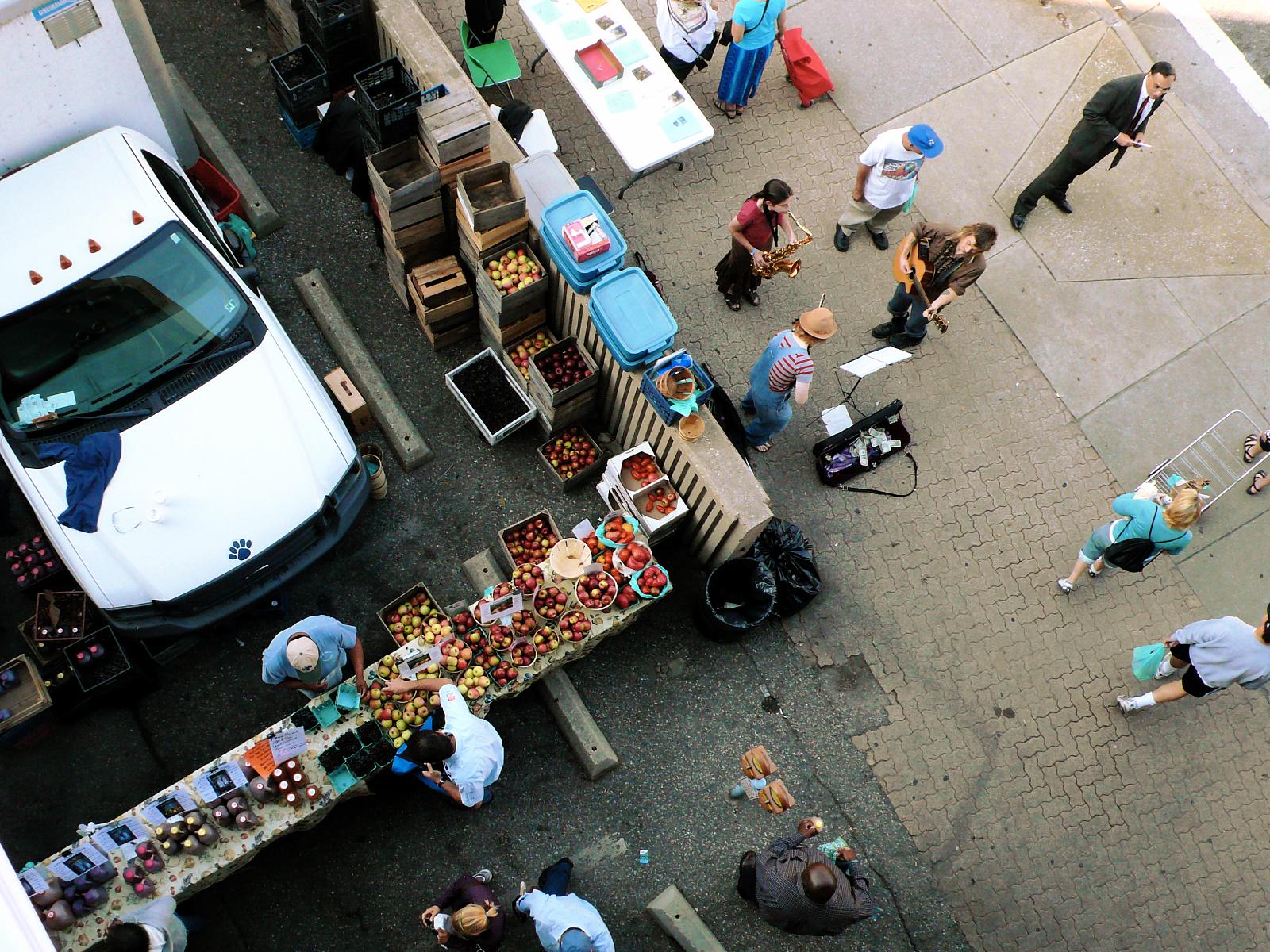Early in November, a 103-year-old restaurant in Massachusetts presented the “world premiere” of a new local speciality to an audience of four. They looked like ordinary crab cakes, nestled in a bed of microgreens on a sesame seed bun and accompanied by a side of coleslaw. But these cakes were the first ever made using mince from the invasive green crab.
Steve Woodman, third-generation CEO of Woodman’s of Essex—”a Yankee tradition since 1914”—seemed cautiously enthusiastic. “Tasty,” he said. “Very good flavor.”
At first glance, Woodman’s seems an unlikely champion of the kind of “eat your invasives” fervor that enraptures ecologists, progressive chefs, and often no one else. With the exception of marketing “gluten-free” clam chowder, the menu doesn’t seem to have changed much in the last hundred years—it’s a typical New England seafood shack serving fried fish sandwiches, lobster rolls, and clam cakes with tartar sauce and French fries. (The model clearly works: pictures on the wall show lines snaking down the block in summertime, and Forbes named it the “Best Seafood in America” in 2001).
 Claire Brown
Claire Brown The pick-up counter at Woodman’s of Essex
But Woodman owes his fortune to a similarly wild idea, conceived in 1916: His grandfather “Chubby” claimed to invent the fried clam. At the time, Woodman says, clams were cheap and used as bait. Business was slow one summer day, and a customer joked that Chubby should use his potato-chip fryer to cook the hand-raked clams he sold at his sundries store. Chubby battered them up, fried a few batches, and tested the concept by selling them during the town’s July Fourth parade. He made $35 that day.
The recipe caught on, and imitators sprung up all over New England. Today, a single serving of fried clams sells at Woodman’s for $28.99. It’s this kind of baitfish-to-billions success story that advocates hope to spur for green crabs. Because if people want to eat them, commercial fishermen will want to catch them. And if commercial fishermen catch more of them, the logic goes, the crabs might stop eating baby shellfish. And mowing down all the eelgrass. And wreaking general havoc on both coasts.
But Woodman’s chef Ned Grieg hadn’t stumbled on these crabs on the marsh fifty yards from the restaurant’s door, nor had he bought them on a whim at a seafood market. It took nearly a dozen chefs, researchers, citizen-scientists, seafood-industry allies, and one fine art conservator to put the green crab cakes on our paper plates. And if they have their way, we’ll soon be eating soft-shell crabs in the summertime, green crab caviar in autumn, and crab cakes all year round.
 Claire Brown
Claire Brown Roger Warner prepares to pull in green crab traps on the Great Marsh in Massachusetts
Warner lives on the Great Marsh, a spidery network of estuaries, creeks, and marshy grasslands that stretches through eight towns in the Upper North Shore region of Massachusetts, about an hour northeast of Boston. It’s one of a handful of green crab “hot spots” along the Eastern Seaboard—they’re abundant in Maine’s Casco Bay and Nova Scotia as well—because it’s protected from the open ocean and full of soft-shell clams, which they love to eat.
 Claire Brown
Claire Brown A map of the Massachusetts Great Marsh—where green crabs have few natural predators—hangs on Roger Warner’s wall
The crabs, which are native to Europe, hitched a ride to New England on fishing vessels sometime during the 1800s and never left. “It’s like Club Med for them,” says Alyssa Novak, a research assistant professor at Boston University, on a phone call.
And she’s right: Parts of the East Coast are paradise for the crabs. As a result, their populations have spread far and wide, appearing in some places in numbers 10 and 20 times what ecologists consider harmful to other aquatic species. Green crab specialists on both coasts have launched initiatives that attempt to control populations simply by pulling them out of the water; in some cases, those efforts have led to even higher populations in subsequent years.
We’re joined on our excursion by Mary Parks, marketing director for the Green Crab R&D Project who during the day works as an environmental compliance and data manager for Boston-based seafood company Red’s Best. She says she grew up seeing layers of green crabs on the ocean floor when she free-dived at home in Maine.
The boat motors around the marsh as a pair of blue herons cruises over the shallows nearby. Warner pulls trap after trap out of the water, each filled with the clicking sound of flexing claws and a single, gleaming white fish skeleton (yesterday’s bait). The traps are teeming with stacks of palm-sized crabs, and some of them indicate their displeasure at being interrupted from their feast by stretching both claws toward the sky—ready for attack. Warner says that, left to their own devices, the crabs can survive for up to two weeks in a cooler without another meal—though many will feast on their friends, given the opportunity.
Roger Warner hauls a green crab trap in Ipswich, MA
Against the placid backdrop of gently swaying marsh grasses and New England fall foliage, it’s difficult to reconcile the calm waters and fishing cormorants with the existential threat crawling just below the surface. Up close, the green crab doesn’t look like it’s capable of eating thirty clams a day—the largest one I saw was no bigger than four inches—and it’s hard to see its claws as a threat to a finger, much less to an entire ecosystem.
But on a dock where we pull in the biggest haul of the day, Warner plunges his hand into the water and pulls a mass of young mussels and kelp from under the wooden platform. He says that the marsh used to be home to abundant mussel flats, but populations have died back in recent years, a phenomenon he blames on the crabs. (Novak later emphasizes that scientists aren’t totally sure where, exactly, the mussel flats used to be.)
 Claire Brown
Claire Brown Green crabs can eat up to 30 young shellfish each day
The crabs do more than just eat young shellfish. In Massachusetts alone, they’ve wiped out about a thousand acres of eelgrass, an underwater plant that purifies the water and acts as a nursery habitat for all kinds of species. “They are known to come in and clean out a whole area and make it barren,” Novak says.
Because they were introduced to East Coast waters by fishing vessels, the crabs lack natural predators in the Great Marsh. In Italy, where they are fished for food, males are plagued by a castrating barnacle; in Massachusetts, no such natural intervention keeps them under control. In the past, clammers have depended on cold winters to keep populations in check. But the past few winters haven’t been as frigid, and Novak says the green crab populations are at a 30-year high. This may be the new normal. “Regardless if we get some cold winters in there, I think the green crabs are still going to be an issue, because we have an issue with climate change and the warming waters in general,” she says. “So that’s contributing to their populations.” According to the Portland Press-Herald, the Gulf of Maine has been warming faster than anywhere on the planet except for a spot just above Japan since 2004.
Elsewhere, fisheries on the West Coast are starting to pull in traps with a hundred crabs at a time—still well above the 30- to 40-crab “problem” threshold but below the numbers in the Great Marsh.
Back on shore, Warner lights a portable stove under a giant pot of water. He sets up a slanted wooden chute and positions a plastic bin under its open mouth. He pours a hundred or so crabs into the top of the chute, pulling the females—easily distinguishable based on the shape of their tail flaps—into a bin at his feet as the males skitter down the slope and fall into the waiting bin. We’ll continue to sort the crabs this way until the traps are empty and the bins are full; meanwhile, Warner cooks the first batch of females in boiling water. Later, we’ll extract their bright orange roe.
Mary Parks shows the difference between a female and male crab. The arrow-like plate on the male underbelly is narrower than the female’s
Here’s the logic: Right now, the crabs have little economic value. They’re just pests, and no one really eats them. But if people start recognizing them as a delicacy, their value will skyrocket overnight. Sound improbable? It worked for the lobster, which was once served only to prisoners. It also worked for the clam. And the oyster.
Catching the crabs is no problem. Trappers in Ipswich already catch tens of thousands of them each year—the town subsidizes crab capture at about 25 to 40 cents a pound in an effort to protect its clam flats—and those crabs are either turned into compost or sold to New Jersey fishermen as bait (tautogs are crazy about them). But the town’s subsidies are a temporary solution, and the crabs don’t fetch a whole lot of profit when they’re sold for bait. The Project’s goal is to create a sustainable market for the green crabs as seafood so that as populations continue to rise, market forces will keep them at bay.
The trick is to convince seafood companies to pay higher-than-bait prices for something that’s currently dirt cheap. That’s not going to be easy. But members of the R&D project have a few ideas up their sleeves.
 Claire Brown
Claire Brown The green crabs turn red when cooked
“I suddenly went, ‘Wait a minute! Are these the same crabs that we’re having problems with in Maine?’” says Taggart. They weren’t exactly the same, but they were very close. “That’s when I started to ask the question, ‘why aren’t we doing this?’”
Taggart struck up a collaboration with a scientist back in Maine. They wanted to figure out how to catch the crabs right after they molt, when their shells are still soft and they can be deep-fried and eaten whole. Eventually, Taggart connected with a family of Venetian molechante—that’s the word for people who catch green crabs for a living—and convinced them to share their knowledge. “I ponied up my frequent flier miles and headed over there,” Taggart says.
The Venetian fishermen use a complex system of zig-zagging nets to catch the crabs. Taggart estimates they catch about a thousand pounds per day, then sort them using the same kind of wooden chute Warner had set up in Ipswich (inspired, of course, by Taggart’s travels). Of the thousand pounds they net, about a hundred pounds are close to molting. The molechante put those almost-soft-shell crabs into a series of underwater cages and check on them twice a day. Once a crab has molted, the fishermen have a roughly 24-hour window to chill it and stop its shell from hardening. But it’s well worth the effort: Taggart estimates the soft-shell crabs sell for $25 to $45 per pound.
“Deep frying is the traditional way of cooking them,” Taggart says. “I have ten different recipes for how to do the batter, whether just dipped in water and flour, or seawater and flour, or Venetian lagoon water and flour… they’re all basically deep fried.” He adds that in one region, where the crabs are dipped in egg and milk, the creatures actually ingest a lot of the dairy before they’re cooked. His molechante friends sneered at that recipe, saying that “they just blow up,” and “they taste like egg.”
Back in New England, Taggart and his collaborators don’t have generations of expertise on their side. But that hasn’t stopped them from trying to catch green crabs in the middle of their molt. They catch the crabs in lobster traps, then keep the traps underwater and check them periodically for molting individuals. Once a crab looks ready to go, they move it into a tiny individual cage—a “jail cell”—until it’s soft-shelled.
Taggart is a proponent of the traditional Venetian method of keeping the crabs in cages underwater until after they molt. He knows of at least one Canadian aquaculturist who has tried—without much success—to molt green crabs in an artificial setting. And Warner mentioned that he hoped to find a way to scale the process, keeping the crabs in salmon trays or other holding pens where they can be monitored frequently.
But the Venetian method is labor-intensive, and Taggart is designing the celled cages himself. A recent wire-based design stacked the crabs on top of each other. Some of their limbs stuck out, and their neighbors—being crabs—took advantage. “Their brethren ate off their legs,” Taggart laughs.
Still, about half of Taggart’s molted crabs survived this year. He delivered them to local chefs, admonishing them to thin out their normal frying batter to let the crabs’ flavor shine through. Restaurants charged about $25 a pound, and diners were enthusiastic.
“Everyone said that they could’ve charged more than they did initially. But they thought that this was the price the market would bear. And then they all vanished instantly. One chef raised the prices and they all vanished,” Taggart says.
Taggart and Warner agree that soft-shell crabs are the “gold standard” for getting green crabs onto menus. They’re delicious, they’re steeped in tradition, and—perhaps most importantly—they don’t need to be processed once they’re out of the water.
But the summertime molting season represents a tiny sliver of the year, and East Coast fishermen are a long way from perfecting the process. They may never catch enough soft-shell crabs to move the needle on population numbers. That’s why, on the fall day I visited, Warner was testing another recipe: Crab caviar.
A few minutes in boiling water turns the crabs from vibrant green to fiery red. Once the female crabs are cooked, extracting their roe is a simple process involving chopsticks and elbow grease.
After the crabs are cooked, Mary Parks and Roger Warner extract the roe from the female crabs
Taggart discovered mazanetta on a second trip to Italy. Female crabs lay their eggs in the fall, and the molechante sell egg-bearing females when the soft-shell season is over. For people hoping that eating green crabs will have a serious impact on their population size, mazanetta is even more exciting than soft-shell crabs: A female crab lays about 160,000 eggs every year. That means each order of crab caviar could potentially prevent thousands of crabs from ever being born.
But convincing diners to eat green crab caviar on the half shell may be a hard sell, especially considering the mazanetta doesn’t visually match the pure orange roe associated with blue crab caviar. The substance scooped from green crab cavities contains thousands of tiny orange eggs, sure, but they’re coated with the grayish green tomalley—a small amount of meat that shatters the illusion of eating thousand-dollar Imperial Gold.
Chefs can also use the mazanetta in a dish that’s more familiar to East Coast eaters, especially those from the South: Parks says she hopes it’ll catch on as a substitute for blue crab roe, a key ingredient in She-Crab Soup. Many states have illegalized the harvest of sponge crabs (egg-bearing blue crabs) since the populations are so valuable; why not market green crab roe as a locally available alternative rather than shipping blue crab roe in from Vietnam?
Our low-tech mazanetta operation in Ipswich yields a Ziploc baggie full of roe. It’s a time-consuming process. At scale, a roe-extraction operation would require human pickers—an additional investment for any processing company looking to invest in selling green crabs.
There’s one more method of turning these crabs into food that requires neither generations of fishing knowledge nor human pickers: feeding cooked crabs into a mincing machine. The machine, common in the seafood industry, can separate the shell from the meat if calibrated correctly. A researcher in Maine has been working with the mince—I interviewed her back in June—and she shared some of the product with Taggart and Warner.
As we drive toward the restaurant, Warner stops his car to retrieve the mince from the freezer. It’s not as sexy as the caviar or the soft-shell crabs—it looks like a gray, pureed mass—but it’s by far the least labor-intensive method of dealing with the trapped crabs. Mince does not discriminate between male and female. Mince does not discriminate between soft and hard.
“In the lobster industry, there’s lobster mince out there which you’ve probably never heard about either. There is a market for lobster mince, especially for flavor,” Taggart says. “What I imagine you’d be doing with this—you’d be using it as a flavor base in any of the fish soups.”
At Woodman’s of Essex a few minutes down the road, Warner greets CEO Steve Woodman and chef Ned Grieg like old friends. He’s brought along a bucket of cooked crabs, a bucket of live crabs, our baggie full of roe, and another Ziploc filled with frozen mince.
It’s not long before Grieg emerges from the kitchen with plate after plate of fresh crab cakes. In one version of the dish, he’s used only the mince. In another, he’s combined the mince with the mazanetta. Later, he surprises us with a bisque made with crab roe, crab meat, cognac, and roux.
 Claire Brown
Claire Brown Green crab cakes at Woodman’s of Essex
“I think that’s got more flavor than, say, the lump crab,” he says of the crab cakes.
The mince-based cake is dense, and the mince itself is a little gritty (remember, it’s a first-time effort for the mince machines). But the flavor is sweet and clean, and Woodman says he’d put it on the menu if the price was right. The roe-mince mix has a much stronger fishy flavor. “It’s different. You can taste the roe. It’s nice,” Woodman says. Also, “I would definitely try to make these gluten-free.” The bisque proves to be the most successful use of the roe—the cream does a lot to mellow out the flavor, which is naturally brackish.
Everyone acknowledges it’ll be a long time before Woodman’s can put green crabs on the menu permanently. But Grieg mentions he’s already planning to use them as a one-off dish in an upcoming catering event where the guests asked for them by name.
Near the end of the tasting, Michael Trupiano walks in to try the crab. He’s the general manager at local shellfish processing facility—one of the missing links in the green crab supply chain. Warner mentions he’s been hounding Trupiano to process some female crabs to test his market for mazanetta. Eventually, Trupiano says he’ll run a test batch.
There it is: A potential willing processor, another link in the chain. No one knows if chefs will go for mazanetta—and if they do, whether it’ll be worth $5 a pound, or $50, or $500. But every taste test represents a few more crabs out of the sea. Who knows? Maybe someday, we’ll be stopping at green crab shacks on the way home from the beach.
Correction: In an earlier version of this story Michael Truviano’s name was spelled incorrectly. The correct spelling is Michael Trupiano. We regret the error.
